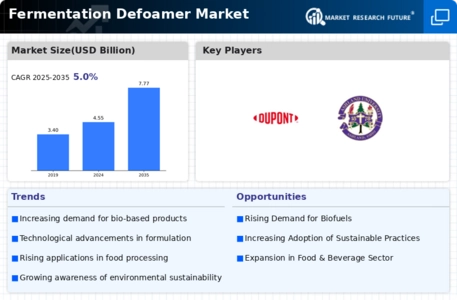Expansion of the Beverage Industry
The rapid expansion of the beverage industry, particularly in the non-alcoholic segment, is a significant driver for the Fermentation Defoamer Market. With the increasing popularity of craft beverages, including hard seltzers and flavored waters, manufacturers are facing challenges related to foam control during fermentation. This growth in the beverage sector is projected to continue, with market analysts forecasting a compound annual growth rate of approximately 6% over the next few years. As beverage producers seek to optimize their fermentation processes, the demand for effective defoamers is likely to rise, further propelling the Fermentation Defoamer Market.
Rising Demand for Fermented Products
The increasing consumer preference for fermented products, such as yogurt, kefir, and kombucha, is driving the Fermentation Defoamer Market. As health-conscious consumers seek out probiotic-rich foods, manufacturers are ramping up production. This surge in demand necessitates the use of fermentation defoamers to enhance the efficiency of the fermentation process. According to industry estimates, the fermentation sector is projected to grow at a compound annual growth rate of approximately 8% over the next five years. This growth is likely to propel the need for effective defoaming agents, ensuring that manufacturers can meet production targets while maintaining product quality. Consequently, the rising demand for fermented products is a key driver for the Fermentation Defoamer Market.
Innovation in Fermentation Technologies
Advancements in fermentation technologies are reshaping the Fermentation Defoamer Market. Innovations such as continuous fermentation processes and bioreactor designs are enhancing production efficiency and product yield. These technological improvements often lead to increased foam formation during fermentation, necessitating the use of effective defoamers. As companies adopt these new technologies, the demand for specialized fermentation defoamers is likely to rise. The fermentation technology market is anticipated to grow significantly, with projections indicating a potential increase in market size by over 10% in the coming years. This trend underscores the importance of innovation as a driver for the Fermentation Defoamer Market.
Growing Awareness of Sustainable Practices
The shift towards sustainable practices in food production is influencing the Fermentation Defoamer Market. Consumers are increasingly concerned about the environmental impact of food manufacturing processes, prompting companies to adopt eco-friendly defoaming agents. This trend is reflected in the rising demand for biodegradable and non-toxic defoamers, which align with sustainability goals. The market for sustainable food additives is expected to expand, with estimates suggesting a growth rate of around 7% annually. As manufacturers strive to meet consumer expectations for sustainability, the adoption of environmentally friendly fermentation defoamers is likely to become a key driver in the Fermentation Defoamer Market.
Regulatory Compliance and Quality Standards
Stringent regulations and quality standards imposed by food safety authorities are influencing the Fermentation Defoamer Market. Manufacturers are required to adhere to specific guidelines regarding the use of additives, including defoamers, in food production. Compliance with these regulations not only ensures product safety but also enhances consumer trust. As a result, companies are increasingly investing in high-quality fermentation defoamers that meet regulatory requirements. The market for food additives, including defoamers, is expected to witness steady growth, with a projected increase in value reaching several billion dollars by 2026. This regulatory landscape is thus a significant driver for the Fermentation Defoamer Market, as it compels manufacturers to prioritize quality and compliance.


















Leave a Comment